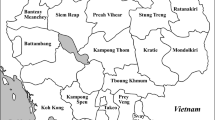Abstract
Genetic relationships among 125 Spanish melon (Cucumis melo L.) accessions from a Spanish germplasm collection were assessed using a standard molecular-marker array consisting of 34 random amplified polymorphic DNA (RAPD) markers bands (19 primers) and 72 reference accessions drawn from previous studies. The reference accession array consisted of a broad range [Japanese (19) Crete (17), African (15), and USA and Europe (US/EU, 21)] of horticultural groupings (Group Cantalupensis, Group Conomon, Group Inodorus, Group Flexuosus, and Group Chito), and of melon market classes (e.g., Charentais, U.S. Western and European Shipper types, Ogen, and Galia, Honeydew, and Casaba). Spanish melon accessions (largely Casaba, Group Inodorus) were genetically distinct from the reference accessions and other Group Inodorus melons of different origins. Most African accessions showed common genetic affinities, and grouped with the Group Chito and the Group Conomon accessions examined. Those accession groupings were distinct from all other accessions belonging to Group Cantalupensis, Flexuosus, and Inodorus accessions originating from Crete, Japan, Europe, and the U.S. Genetic diversity was highest in accessions of African origin and lowest in accessions of Spanish origin. Additional RAPD markers (49 primers, 141 bands) and 22 selected agronomic traits (quantitative and qualitative) were then used to assess the genetic diversity among Spanish accessions. While cluster analysis using fruit characteristics grouped accessions into cultivars, RAPD-based genetic-distance estimate did not provide consistent accession groupings either by cultivar or geographic origin. While the highest level of polymorphism was detected among melons originating from the central region of Spain, and in the Rochet cultivar, accessions from the Andalucía region and Green cultivars were comparatively less diverse. These results indicate that the Spanish melon accessions could be used to broaden the genetic base of local and foreign Casaba germplasm, to enhance the genetic diversity of U.S and European commercial melon germplasm, and to delineate collection strategies for acquisition of additional Spanish landraces.



Similar content being viewed by others
References
Anastasio G, Costa J, Abadia J, Gómez-Guillamón ML, Cuartero J, Alonso-Allende A, Moreno A, Nuez F (1986) Evaluación de cultivares autóctonos de melón. Actas del II Congreso Nacional de la SECH, Córdoba, 21–25 abril 1986, pp 1267–1274
Baudracco-Arnas S, Pitrat M (1996) A genetic map of melon (Cucumis melo L.) with RFLP, RAPD, isozyme, disease resistance and morphological markers. Theor Appl Genet 93:57–64
Bretting PK, Wirdlechner MP (1995) Genetic markers and plant genetic resource management. Plant Breed Rev 13:11–86
Costa J, Catalá MS, Cortés C, Nuez F, Abadía J, Cuartero J (1989) Evaluación de la variabilidad en los principales tipos de melon cultivados en España. Invest Agric: Prod Prot Veg 4:43–57
Esquinas-Alcázar JT (1977) Alloenzyme variation and relationships in the genus Cucumis. PhD Dissertation, University of California, Davis
Esquinas-Alcázar JT, Gulick PJ (1983) Genetic resources of Cucurbitaceae. A.G.P.G.R.: I.B.P.G.R./83/84:20, Rome
Fanourakis N, Tsekoura Z, Nanou E (2000) Morphological characteristics and powdery mildew resistence of Cucumis melo land races in Greece. In: Katzir N, Paris HS (eds) Proc 7th Eucarpia Meeting on Cucurbit Genetics and Breeding. Ma'ale Ha Hamisha, Israel. Acta Hort 510:241–245
García E, Jamilena M, Álvarez JI, Arnedo T, Oliver JL, Lozano R (1998) Genetic relationships among melon breeding lines revealed by RAPD markers and agronomic traits. Theor Appl Genet 96:878–885
Gómez-Guillamón ML, Cuartero J, Cortés C, Abadía J, Costa J, Nuez F (1983a) Descripción de cultivares de melón: caracteres cuantitativos. Actas del I Congreso Nacional de la Sociedad Española de Ciencias Hortícolas. Valencia, 28 Noviembre–1 Diciembre 1983, pp 453–460
Gómez-Guillamón ML, Cuartero J, Cortés C, Abadía J, Costa J, Nuez F (1983b) Descripción de cultivares de melón: Caracteres cualitativos. Actas del I Congreso Nacional de la Sociedad Española de Ciencias Hortícolas. Valencia, 28 Noviembre–1 Diciembre 1983, pp 461–470
Gómez-Guillamón ML, Abadía J, Cuartero J, Cortés C, Nuez F (1985) Characterization of melon cultivars. Cucurbit Genet Coop Rep 8:39–40
Gómez-Guillamón ML, Torés JA, Soria C, Sesé AIL (1995) Screening for resistance to Sphaerotheca fuliginea and two yellowing diseases in Cucumis melo and related Cucumis species. In: Lester G, Dunlap J (eds) Proc Cucurbitaceae'94. Evaluation and Enhancement of Cucurbit Germplasm. South Padre Island, Texas, USA, pp 205–208
Gómez-Guillamón ML, Sánchez F, Fernández-Muñoz R (1998) Caracterización de cultivares de melón. Actas de las Jornadas de Selección y Mejora de Plantas Hortícolas. Córdoba, September 1998
Greuter W, McNeill J, Barrie FR, Burdett HM, Demoulin V, Filgueiras TS, Nicolson DH, Silva PC, Skog JE, Trehane P, Turland NJ, Hawksworth DL (eds. and compilers) (2000) International Code of Botanical Nomenclature (St. Louis Code). Regnum Veg 138:1–474
Horejsi T, Staub JE (1999) Genetic variation in cucumber (Cucumis sativus L.) as assesssed by Random Amplified Polymorphic DNA. Genet Res Crop Evol 46:337–350
Jaccard P (1908) Nouvelles reserches sur la distribution florale. Bull Soc Vaud Sci Nat 44:223–270
Jackson DA, Somers KM, Harvey HH (1989) Similarity coefficients: measurements of co-occurrence and association or simply measures of occurrence? Am Nat 133:436–453
Kirkbride Jr JH (1993) Biosystematics monograph of the genus Cucumis (Cucurbitaceae). Parkway Publishers, Boone, North Carolina
Lanaud C, Lebot V (1997) Molecular techniques for increased use of genetic resources. In: Ayad WG, Hodgkin T, Jaradat A, Rao VR (eds) Molecular genetic techniques for plant genetic resources. International Plant Genetic Resources Institute, Rome, Italy, pp 92–97
López Sesé AI, Staub J, Katzir N, Gómez-Guillamón ML (2002) Estimation of between and within accession variation in selected Spanish melon germplasm using RAPD and SSR markers to assess strategies for large collection evaluation. Euphytica 127:41–51
Maniatis T, Fritsch EF, Sambrook J (1982) Molecular cloning: a laboratory manual. Cold Spring Harbour Laboratory Press, Cold Spring Harbour, New York
McCreight JD, Nerson H, Grumet R (1993) Melon, Cucumis melo L. In: Kallos G, Bergh BO (eds) Genetic improvement of vegetable crops. Pergamon Press, New York
Mliki A, Staub JE, Zhangyong S, Ghorbel A (2001) Genetic diversity in melon (Cucumis melo L.): an evaluation of African germplasm. Genet Res Crop Evol 48:587–597
Molina RV, Cuartero J, Gómez-Guillamón ML, Abadia J, Nuez F (1986) Variabilidad inter e intracultivar en melón. Actas del II Congreso Nacional de la SECH. Córdoba, 21–25 abril 1986, pp 1293–1300
Munger HM, Robinson RW (1991) Nomenclature of Cucumis melo L. Cucurbit Genet Coop Rep 14:43–44
Nakata E, Staub JE, López-Sesé A, Katzir N (2003) Genetic diversity in Japanese melon (Cucumis melo L.) as assessed by random amplified polymprphic DNA and simple sequence repeat makers. Theor Appl Genet (in press)
Naudin C (1859) Review des cucurbitacées cultivées on Museum. Ann Sci Natl Ser 4 Bot 12:79–164
Neuhansen SL (1992) Evaluation of restriction fragment length polymorphisms in Cucumis melo. Theor Appl Genet 83:379–384
Nuez F, Anastasio G, Cortés C, Cuartero J, Gómez-Guillamón ML, Costa J (1986) Germplasm resources of Cucumis melo L from Spain. Cucurbit Genet Coop Rep 9:60–63
Nuez F, Ferrando C, Díez MJ, Costa J, Catalá MS, Cuartero J, Gómez-Guillamón ML (1988) Collecting Cucumis melo L. in Spain. Cucurbit Genet Coop Rep 11:54–56
Nuez F, Prohens J, Díez MJ, Fernández de Córdova P (1994) Cucumis melo L. accessions of the gene bank of the Polytechnic University of Valencia. Cucurbit Genet Coop Rep 17:57–60
Perl-Treves R, Zamir D, Navot N, Galun E (1985) Phylogeny of Cucumis based on isozyme variability and its comparison with plastome phylogeny. Theor Appl Genet 71:430–436
Pitrat M, Hanelt P, Hamer K (2000) Some comments on infraspecific classification of cultivars of melon. Acta Hort 510:29–36
Rohlf FJ (1997) NTSYS-pc. Numerical taxonomy and multivariate analysis system. Version 1.8. Exeter Software, New York
Spooner DM, Tivang J, Nienhuis J, Miller JT, Douches DS, Contreras M (1996) Comparison of four molecular markers in measuring relationships among wild potato relatives Solanum section Etuberosum (subgenus Potato). Theor Appl Genet 92:532–540
Staub JE, Serquen F, Gupta M (1996) Genetic markers, map construction and their application in plant breeding. HortScience 31:729–741
Staub JE, Box J, Meglic V, Horejsi TF, McCreight JD (1997) Comparison of isozyme and random amplified polymorphic DNA data for determining intraspecific variation in Cucumis. Genet Res Crop Evol 44:257–269
Staub JE, Danin-Poleg Y, Fazio G, Horejsi T, Reis N, Katzir N (2000) Comparison analysis of cultivated melon groups (Cucumis melo L.) using random amplified polymorphic DNA and simple sequence repeat markers. Euphytica 115:225–241
Staub JE, Dane F, Reitsma K, Fazio G, López-Sesé AI (2002) The formation of test arrays and a core collection in cucumber using phenotypic and molecular marker data. J Am Soc Hort Sci 127:558–567
Staub JE, Fanourakis N, López-Sesé A (2003) Genetic diversity in melon (Cucumis melo L.) landraces from the island of Crete as assessed by random amplified polymorphic DNA and simple sequence repeat markers. Genet Res Crop Evol (in press)
Stepansky A, Kovalski I, Perl-Treves R (1999) Intraspecific classification of melons (Cucumis melo L.) in view of their phenotypic and molecular variation. Plant Syst Evol 217:313–332
Yeh FC, Yang RC, Boiley T, Ye Z-H, Mao JX (1997) POPGENE, the user-friendly shareware for population genetic analysis. Molecular Biology and Biotechnology Center, University of Alberta, Canada
Zhang Q, Gao YJ, Saghai Maroof MA, Yang SH, Li JX (1995) Molecular divergence and hybrid performance in rice. Mol Breed 1:133–142
Acknowledgements
This research was supported in part by a grant from the "Secretaría de Universidades, Investigación y Desarrollo" of the Spanish Department of Education and Culture, Madrid, Spain, and to the European Union for the project RESGEN-CT99-8 on phytogenetic resources of melon.
Author information
Authors and Affiliations
Corresponding author
Additional information
Communicated by C. Möllers
Mention of trade name, proprietary product, or specific equipment does not constitute a guarantee or warranty by the USDA and does not imply its approval to the exclusion of other products that may be suitable.
Rights and permissions
About this article
Cite this article
López-Sesé, A.I., Staub, J.E. & Gómez-Guillamón, M.L. Genetic analysis of Spanish melon (Cucumis melo L.) germplasm using a standardized molecular-marker array and geographically diverse reference accessions. Theor Appl Genet 108, 41–52 (2003). https://doi.org/10.1007/s00122-003-1404-z
Received:
Accepted:
Published:
Issue Date:
DOI: https://doi.org/10.1007/s00122-003-1404-z




